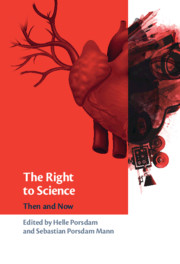Freedom of scientific enquiry. Integrity of research. Universal access to science education. Sharing knowledge and discoveries as a public good. Open access to academic research. International cooperation through scientific collaboration. Scientifically sound public policy. Broad participation in scientific enquiry. Attention to the needs of vulnerable communities. Widespread access to new technologies. Patent policy as a means to this end. Free and informed participation in experiments and new technologies. These are among the central themes of the internationally recognized human right to participate in the process of scientific discovery and to share in the benefits of technological progress – what has only very recently come to be shorthanded as “the right to science.” As the book now in front of you will make clear in greater detail, the right to science is a philosophical ideal, a legal promise, a political discourse, and – perhaps – a social movement.
Its seed was firmly planted in Article 27 of the Universal Declaration of Human Rights, now over 80 years ago. Some three decades later, the young shoot was transplanted into Article 15 of the International Covenant on Economic, Social and Cultural Rights. The philosophical ideal thus became a legal promise. Yet, for many decades, this promise had little practical impact. The right to science received too little light and nourishment to grow into its potential. Even human rights experts remained unsure how to interpret and apply these most obscure of all the international human rights treaty provisions. About two decades ago, however, the seedling finally found fertile soil at the American Association for the Advancement of Science, the University of Connecticut Human Rights Institute, and the Information Society Project at Yale Law School. At these institutions, Jessica Wyndham and Professor Audrey Chapman provided the critical care at a tender stage. They inspired and welcomed me to join in the work. When I published The Right to Science and Culture in 2010 – then using a different last name – I hoped to provide a conceptual trellis to enable the Article 15 rights to one day achieve a firm foothold within the United Nations human rights system.
That dream has now been realized by the collective efforts of a global network of human right scholars and advocates. Each has grasped his or her own conceptual offshoot and carefully cultivated it. “The right to science and culture” is now the subject of an ample and growing body of scholarship, multiple United Nation Special Rapporteur reports, and at least one ICESCR interpretative commentary. I am reminded of the gardener’s adage about planting and caring for vining plants: “First they sleep. Then they creep. Then they leap!” The Right to Science: Then and Now represents this third stage of accelerating growth. So much is now being written about Article 15, it has become impossible to do justice to both the scientific and cultural aspects in a single volume! The vine is mature. It now depends upon human rights advocates to seize its fruit. A social movement is needed to lay claim to the right, leveraging these new conceptual and legal tools to continuously promote the right to science and defend it from threats.
If you will permit me a second extended metaphor, let us leave the vineyard for wilder land. For contributing authors, participating in an edited volume is a bit like embarking upon a camping trip with very old friends. Most of the writers have known each other for a long time, formed friendships over many an academic gathering, and drawn inspiration from each other’s writings and constructive feedback. Coming together in such a massive collective effort is exciting – and often exhausting – and always exhilarating. Of course, every camping trip succeeds or fails based on the efforts of its organizers. Until you have had the editorial experience yourself, it is impossible to guess at the enormous investment of time and energy required to bring such a volume together. Ironically, it is vastly easier to write one’s own book than to edit a collection of essays! The editors of The Right to Science: Then and Now have been particularly ambitious in including such a diversity of contributors. This scale multiplies the complexity of the conceptual task and organizational labor … but also the richness of the final outcome. For the reader seeking a comprehensive introduction, such a thorough survey of the field is a treat indeed. As you enjoy the volume that follows, I hope you will appreciate the labor of love that it represents, and find your own way to pay it forward.



